Are you looking for a beautiful and unique tree that can live for thousands of years? Then, you may want to check out the ginkgo tree (Ginkgo biloba). Today, we will be talking about the different types of ginkgo trees so you’ll get to know more about this spectacular tree.
Ginkgo trees are living fossils that have not changed for almost 200 million years. They have beautiful fan-shaped leaves that are very unique and the trees are usually either male or female.
It is commonly referred to as “maidenhair tree” due to its duck-foot or fan-shaped leaves that looks like maidenhair fern leaflets (pinnae). Ginkgo tree varieties make unique and attractive ornamental additions to the landscape and can be also used as big shade trees.
Table of Contents
What Are Ginkgo Trees?
Native to China, Ginkgo biloba, also known as maidenhair tree, is a deciduous tree and is a member of the Ginkgoaceae Family, a group of seed-bearing plants also called “prehistoric gymnosperms.” Ginkgo biloba is the only genus and species of this family that still exists.
The oldest ginkgo fossils date back more than 270 million years. Ginkgo trees may live more than a thousand years, as proven by one found in China that is said to be more than 2,500 years old, according to the University of Vermont Extension.
For years, ginkgo trees have always been cherished for their dignified yellow fall color and unique leaf shape. The sole species in this genus is ginkgo biloba, whose leaves are often evenly divided into two lobes.
A ginkgo tree can typically grow up to 80 ft. (24 m) tall and 40 ft. (12 m) wide. Although, there are also some dwarf ginkgo tree varieties, which are smaller species of the tree. Ginkgo tree leaves usually turn to vibrant yellow color early in the fall, and they thrive the best in urban habitats.
The trees have been used as bonsai and in landscapes since ancient times. Although, they are still used in bonsai today, but are now mostly used as popular street trees and as beautiful, low maintenance landscape plants.
Interestingly, ginkgo trees require minimal care to flourish once they mature. But when choosing a ginkgo tree variety, you need to consider the fact that mature female ginkgo trees produce fruit.
The fruit start developing after a period of about 20 years and it can get very messy. The smell is also somewhat irritating to many. More than a hundred varieties of ginkgo trees have become available in recent years.
Finally, Ginkgo thrives in USDA hardiness zones 3 through 8 (Missouri Botanical Garden).
What Is Special About Ginkgo Trees?
Ginkgo trees certainly stands out in several ways. In fact, they are arguably one of the most distinct and attractive of all deciduous trees. It’s unique, fan-shaped leaves that turns yellow in the fall are indeed a beauty to behold.
That’s not all, ginkgo trees establish easily and can survive in different urban conditions including air pollution, heat, salt, and even confined spaces.
What Are Ginkgo Trees Used For?
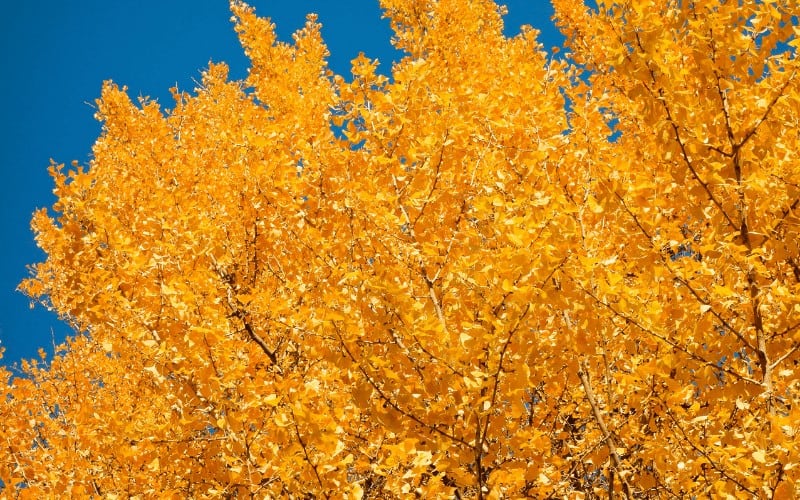
Apart from its ornamental qualities, ginkgo biloba is an herb with lots of medicinal properties. The tree is often used to treat different illnesses, including:
- Cerebral vascular insufficiency
- Dementia
- Cognitive disorders
- Dizziness/vertigo
- Memory loss
- SSRI-induced sexual dysfunction
- Etc.
Types Of Ginkgo Trees
Like I mentioned earlier, there are different ginkgo trees varieties with each of them having different ginkgo tree types under them.
Some of the most common varieties of ginkgo trees include:
- Variegated Variety
- Weeping Ginkgoes Variety
- Dwarf Upright Variety
- Columnar Ginkgoes
- Dwarf Globose Variety
Now, we’re going to look at each of them with their accompanying ginkgo tree types:
Variegated Ginkgo Tree Variety
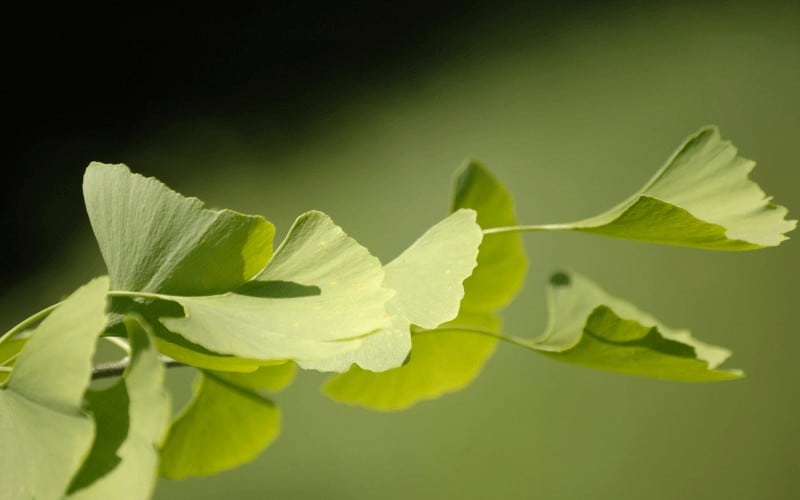
This is perhaps the most popular varieties of ginkgo – and we’re going to look at some of the most common Ginkgo trees that belong to this variety below:
1. Ginkgo biloba ‘Sunstream’
'Sunstream' is a small Ginkgo tree with yellow and green variegated leaves. It has irregular yellow stripes on the leaves that fade to a cream as the leaf matures.
It also has somewhat large leaves with golden-yellow strips that are usually noticeable in the spring period and even into summer. The variegation of Sunstream is probably one of the best among this variety.
The tree grows a bit more vertically than other variegated ginkgo varieties, forming a slim upright tree as it grows older.
2. Ginkgo biloba ‘Majestic Butterfly’
Ginkgo biloba ‘majestic butterfly’ is an upright deciduous tree with remarkable green, yellow, and white variegation. The leaves have varying amount of variegation – and the overall effect is nothing short of stunning.
Founded as a variegated branch mutation on the ‘Jade Butterfly’ cultivar, the Majestic Butterfly has remained one of the favorite ginkgoes for many people.
It retains the variegated coloration throughout the growing season, after which it turns the typical golden yellow color for the fall. With time, majestic butterfly grows into a small tree with a beautiful, rounded canopy.
3. Ginkgo biloba ‘Summer Rainbow’
This is female ginkgo cultivar that has deeply-divided leaves with an attractive striped variegation. Its color increases in summer.
Summer rainbow has a very stable variegation that rarely reverts to green. It also has a relatively ascending side branches with a foliage that is similar to ‘Majestic Butterfly’.
4. Ginkgo biloba ‘Crispin’s Jaded Jester’
Founded by Crispin Silva, this also one of our favorite ginkgo varieties. It is a new variegated variety of ginkgoes that came as a variegated mutation on 'Jagged Jade’.
It has dark, blue-green color leaves just like its parent. Its leaves equally have golden-yellow variegation strips. It also has special coloration and a unique texture.
5. Ginkgo biloba ‘Peve Maribo’
Also known as Peve Lobo, Peve Maribo is a unique variety being one of very few truly variegated dwarf ginkgo tree varieties, developing into a small, globose tree.
This variegated Ginkgo variety originated from Vergeldt Nursery in The Netherlands as a variegated branch mutation on ‘Mariken.’
6. Ginkgo biloba ‘Vanilla Swirl’
Found by Darren Heimbecker in Canada, vanilla swirl ginkgoes have a unique pure white variegation, unlike most other varieties that are yellow or golden variegated.
The variegation is evenly distributed among the plant with half of the branch being green in color and the other half being white. As the leaves mature, the foliage turns green and variegation develops.
The leaves also turned slightly, showing variegation from different angles.
7. Ginkgo biloba ‘Snow Cloud’
Snow Cloud has colorful leaves in the spring period. The yellowish new growth turns to a beautiful snow white when grown in a shade, especially at the edges of its leaves.
The overall effect emerges green or white by mid-summer. Snow Cloud forms an open-branching sculptural shrub.
8. Ginkgo biloba ‘Beijing Gold’
Beijing gold is somewhat similar to Snow cloud as they both have colorful leaves in the spring. In case you don’t know, variegation is basically a term used for ginkgo varieties that have patches of distinctive color together with the regularly-colored foliage.
Beijing Gold, however, feature bright yellow color all over when the leaves first come out in spring. The leaves eventually become more greenish with white to yellow strips on the foliage.
Columnar Ginkgoes Variety
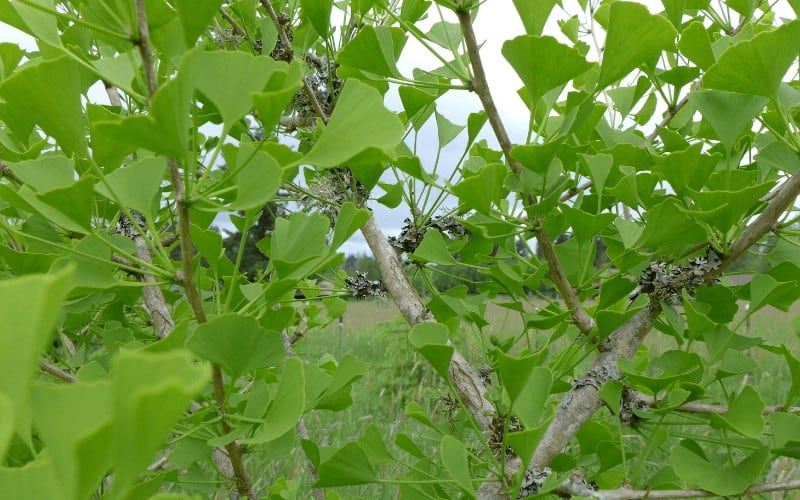
Columnar is another ginkgo tree variety. It’s a fantastic choice for areas in the garden where you want a vertical accent. They have ascending branches and slender habit, which makes them insanely stunning.
That said, below are some of the best upright varieties of columnar ginkgoes:
9. Ginkgo biloba ‘Potter Pete’
Potter Pete is a new variety of columnar ginkgoes. Like other varieties, its side branches point upwards. Interestingly, this variety maintains an amazing narrow habit even at a great age.
10. Ginkgo biloba ‘Fastigiata’
Fastigiata is an excellent option for gardens with limited space as it forms a nice, narrow, vertical accent.
This cultivar has been around for several years now. It’s actually one of the first varieties of columnar ginkgoes. It has a narrow, upright form with a bright green foliage that usually turn golden-yellow in the fall.
11. Ginkgo biloba ‘Elmwood’
For long, ginkgo biloba ‘Elmwood’ was the standard for narrow-growing ginkgo trees, but that was before Menhir came into the scene.
Elmwood produces a single straight trunk with very little side branching until it reaches maturity. Its large and split leaves differentiate it from other similar varieties.
12. Ginkgo biloba ‘Menhir’ (GoGo™)
Native to The Netherlands, Menhir is a new, patented ginkgo tree variety that has a narrow form and blue-green color that turns to rich golden-yellow in the fall.
It has beautiful ascending branches, which made it probably the narrowest type of ginkgo to date.
13. Fairmount
Fairmount is also a columnar ginkgo variety as it has an upright and narrow growth habit. This is a fantastic good choice for narrow spaces that has lots of vertical room.
14. Princeton Sentry
Princeton sentry another type of columnar ginkgo. It grows slightly taller and wider than the Fairmont species – and it also has relatively quick growth.
Dwarf Upright Variety
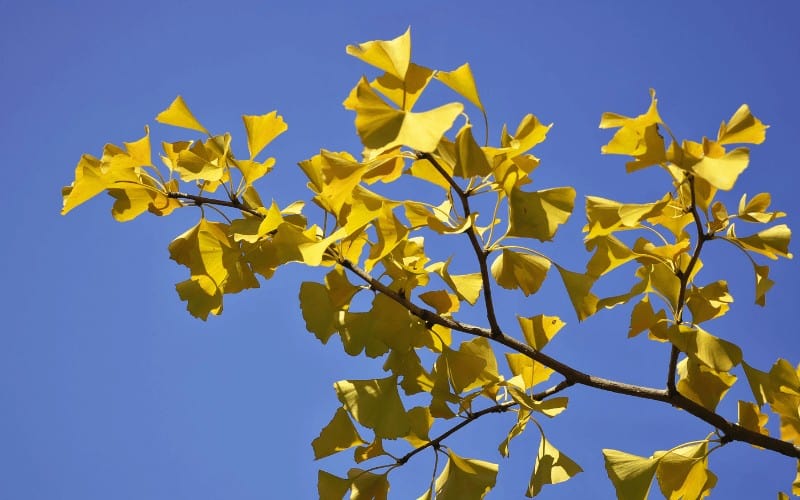
Some upright-growing varieties of ginkgo does not grow to large trees. Some varieties are somewhat slower-growing than a standard Ginkgo biloba but still develop a pyramidal, upright form.
Below are some dwarf upright ginkgo varieties that you should know about:
15. Ginkgo biloba ‘Folkert’s Select’
Popular for its thin, silvery twigs and small leaves that looks like celery, Folkert’s Select is remarkably symmetrical, forming a single leader with somewhat dense, side branches.
It produces a beautiful butter yellow color in the fall.
16. Ginkgo biloba ‘Gokusho-ba’
Gokusho-ba is a fantastic option for bonsai because of its slow growth rate and unique shape.
This a new variety that has a relatively zig-zag, sculptural habit and small, dark-green leaves that are irregularly spaced.
17. Ginkgo biloba ‘Robbie’s Twist’
Found by an expert propagator, Crispin Silva, Molalla, OR, Robbie’s Twist is a small ginkgo tree variety with a thin, strangely-shaped leaves, which are insanely narrow with a twist.
Its stems are equally bent and twisted to a significant extent, giving it its name. Everything on this interesting species is somewhat twisted; from the lenticels on the trunk (giving it a very abnormal look), to swirling leaves.
New growths are usually covered with a fuzzy, brown indumentum – and remains distinctive throughout the year.
18. Ginkgo biloba ‘Chi chi’
Most of the dwarf upright ginkgo varieties mentioned above are all relatively pyramid-shaped, but Chi chi is kind of different in shape. It is slow growth and has a rounded crown with dense.
The leaves changes to a stunning butter-yellow in the fall season. Old shoots develop bigger branches and protrusions referred to as “chi chis” along the trunk.
Weeping Ginkgoes Variety
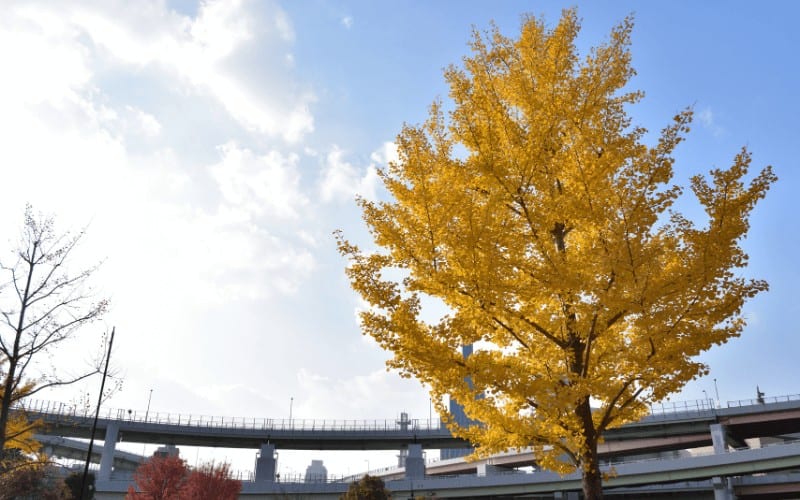
19. Ginkgo biloba ‘Kohout Pendula’
Introduced by Kohout Nursery in Germany, and also known as ‘Kohout Weeping,’ Kohout Pendula is a slow growing tree that is relatively weeping form. This is a male species and will not produce fruit.
It is very similar to Weeping Wonder (mentioned below) with oddly-textured foliage and a fairly pendulous yet upright mounding habit.
20. Ginkgo biloba ‘Weeping Wonder’
Weeping Wonder Ginkgo tree is remarkably unique specimen as its foliage has different shapes. Some of its leaves have a traditional appearance while others are filamentous or tube-like.
This ginkgo tree type is a small, weeping tree with beautiful drooping side branches. It has orange-brown twigs with somewhat dense branching, differentiating it from other larger-growing weeping species like ‘Pendula’ or ‘Umbrella.’
21. Ginkgo biloba ‘Boleslaw Chrobry’
Ginkgo biloba ‘Boleslaw Chrobry’ is a new ginkgo variety from Poland and it’s the best weeping ginkgo variety. It produces large leaves that edges the margins of this irregular-growing weeper.
The Boleslaw Chrobry has a more dramatic weeping aspect than other weeping varieties. This is partly because of its faster growth rate that causes newer growth to noticeably bend down.
Dwarf Globose Variety | Dwarf Ginkgo Tree Varieties
Globe-shaped ginkgoes are considered to be one of the most sought-after types of ginkgoes due to their uses in residential yards and smaller landscapes.
Here are the different types of dwarf globose ginkgoes you may wish to check out:
22. Ginkgo biloba ‘Mariken’
This dwarf Maidenhair Ginkgo Tree was founded as a mutation in 1995 in Holland – and is one of the most famous dwarf ginkgo varieties out there.
It has a very slow rate of growth with fairly large leaves that relatively curls. It is hardy in USDA zones 3 through 8.
23. Ginkgo biloba ‘Troll’
Troll ginkgoes are very similar to Mariken in terms of growth habit and growth rate, but it has a darker green color with a slightly different leaf texture.
This dwarf cultivar produces tiny bunches of rich-green leaves that turn to a brilliant gold in the autumn months. It has a dense, irregular habit, making it an excellent ornamental plant.
24. Ginkgo biloba ‘Buddy’
Found by Bill Barger as a witch's broom in Wadsworth, Ohio. This compact ginkgo produces buds that are very noticeable on the twigs in winter giving it its name.
Buddy is indeed unique and different from other dwarf varieties due to its knob-like buds. Deeply cut leaves are large and a little cupped in spring.
25. Ginkgo biloba ‘Brno’
This is a faster-growing variety that was discovered as a witch's broom in Brno, Czech Republic.
It develops into a broad globe sooner than species like Mariken and Troll, even though it has a dense habit. Brno produces lush foliage during the growing season, making it a favorite to many growers.
Frequently Asked Questions
Is there a dwarf ginkgo tree?
Yes, ginkgoes have dwarf variety. A perfect example is (Ginkgo biloba ‘Mariken’), which looks like a wide, weeping shrub. It grows up to 3 ft. tall and 8 ft. wide.
Do ginkgo trees grow fast?
Yes, there are many fast-growing ginkgo trees. However, if yours are 3 or 4 years old and they haven’t grown much, it’s normal. Some ginkgoes usually experience slow growth rate when they’re young.
After some years, they will start to increase in height by 13 to 24 inches per year.
Are ginkgo trees rare?
Yes, ginkgos were a rare species; however, many people have started cultivating them, making them to quickly spread throughout Eastern Asia.
They’ve also been introduced to North America and Europe, where their hardiness has made them a popular choice for urban planning and landscaping.
Do ginkgo trees have invasive roots?
I'd say, YES, the roots will end up being "invasive if you're planting one ginkgo 5 ft. out from your driveway or house.
Are ginkgo trees poisonous to dogs?
Males ginkgoes are not toxic to dogs and other pets. But the seed from the female species contains ginkgo toxin which is poisonous to dogs. If consumed, your pets may experience irritability, seizures, and vomiting.
Do ginkgo trees stink?
Yes, the female ginkgo trees usually shed their leaves and berries and when this happens, they rot and discharge a stink often likened to dirty gym socks, poop, or vomit.
Are ginkgo trees poisonous?
Yes, they can be mildly toxic. The outer fleshy coating of their seed has chemicals that can lead to dermatitis or blistering just like to poison ivy. That said, ginkgo nuts are high in protein, starch, and niacin, but low in fat.
Read Also:
- Types of Palm Trees
- How To Save a Dying Rubber Tree Plant
- Types Of Palm Trees In Florida
- How to Save a Dying Japanese Maple Tree
- How To Save a Dying Ficus Tree
Conclusion
As you can see, there are different types of ginkgo trees out there with beautiful uses. You just need to choose the one that's most suitable for you and ride with it.




